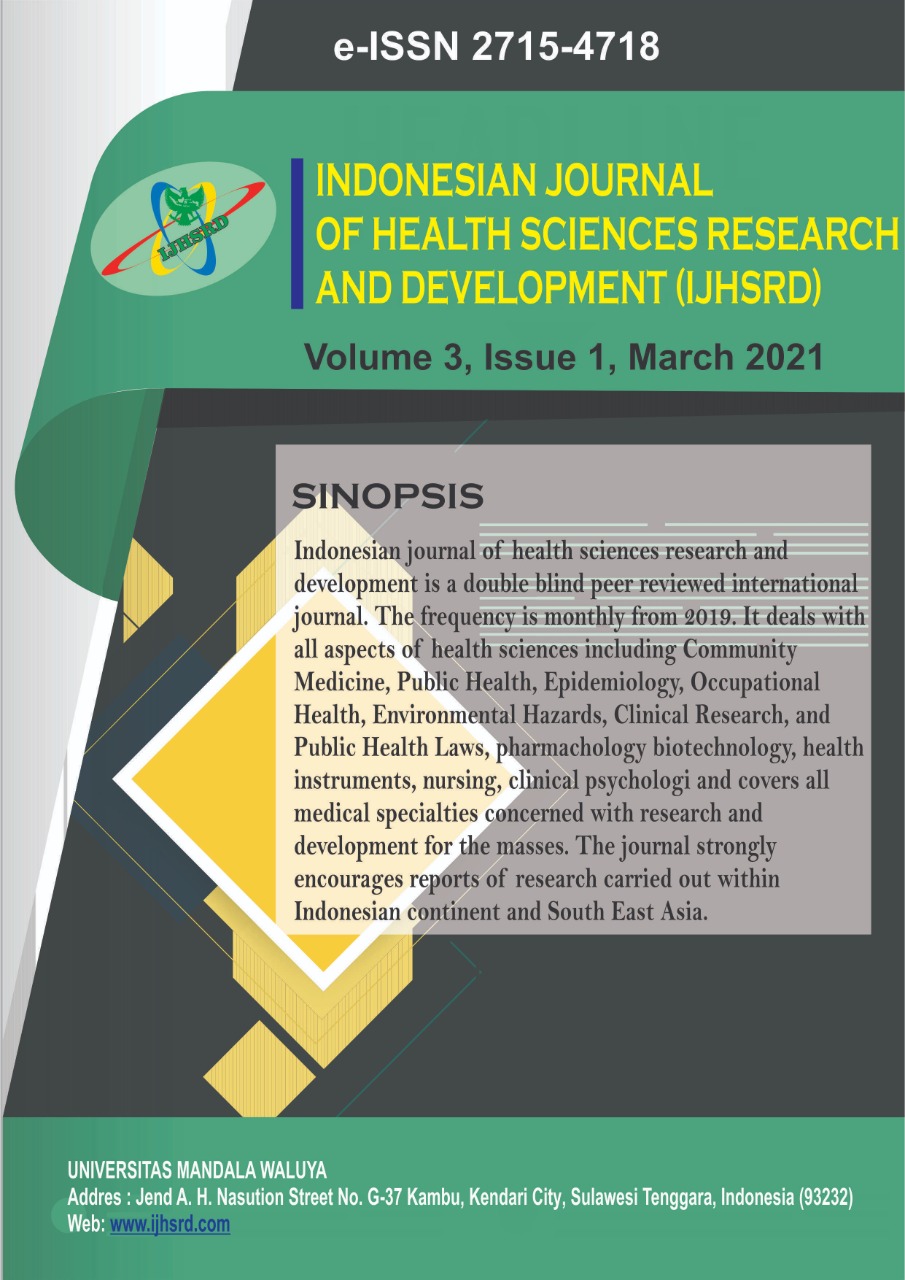Main Article Content
Abstract
Background: Postpartum contraceptive coverage in Konawe Kepulauan Regency in 2018, through data obtained at the Konawe Kepualaun District Health Office, Southeast Sulawesi Province as much as 8.4% and data in 2019 decreased to 1.26%.
Methods:This quantitative research is observational with a cross sectional study design. The population in this study was 96 people with the determination of the sample using stratified cluster sampling, totaling 77 all post-partum mothers in the working area of the health centre in Konawe Kepulauan Regency.
Results:The significance value (p) value of husband support and the role of midwife is 0.000 which means that p <0.05 so that Ha is accepted and Ho is rejected, which means that there is a significant correlation or relationship between husband's support and the role of midwives on the use of postpartum contraception. Both have a value of phi C which is 0.100 which meansvery weak relationship.
Conclusion: There is a relationship between husband's support and the role of the midwife against the use of postpartum contraceptives in the Konawe Islands district.
Keywords
Article Details

This work is licensed under a Creative Commons Attribution-ShareAlike 4.0 International License.
References
- World Health Organization. World health statistics 2015: World Health Organization; 2015.
- Jayadipraja EA, Prasetya F, Azlimin A, Mando WOSY. Family clean and healthy living behavior and its determinant factors in the village of Labunia, Regency of Muna, Southeast Sulawesi Province of Indonesia. Public Health of Indonesia. 2018; 4 (1): 39-45.
- Aryawati W. Development of a Planned and Anticipatory Model of Prevention of High Risk Pregnancy and Childbirth (REGITA). Indonesian Journal of Health Policy: JKKI. 2016; 5 (2): 86-93.
- Anggraeni P. Determinants of Long-Term Contraceptive Method Use (MKJP) for Family Planning Acceptors in the Pamulang Community Health Center 2014: UIN Syarif Hidaayatullah Jakarta: Faculty of Medicine and Health Sciences, 2015; 2015.
- Konawe Islands District Health Office. Coverage of postpartum contraceptive use in Southeast Sulawesi; 2019.
- Mackey A, Gass SM. Second language research: Methodology and design: Routledge; 2015.
- Fatimah D. Factors Related to the Use of Contraceptives in the Womb (IUD) in the Work Area of the Pasar Rebo District Health Center. 2013.
- Wahyuni R, Irawan Y. Web-Based Heart Disease Diagnosis System With Forward Chaining Method (Case Study Of Ibnu Sina Islamic Hospital). Journal Of Applied Engineering And Technological Science (Jaets). 2019; 1 (1): 43-50.
- Ruwayda R. Factors Associated with Post-Copy Kb in Post-partum Mother in the Work Area of Puskesmas Pakuan Baru, Jambi City, 2013. Scientific Journal of Batanghari University, Jambi. 2017; 14 (1): 49-57.
- Notoatmodjo S, Anwar H, Ella N, Tri K. Health promotion at school. Jakarta: inventions. 2012: 21-3.
- RI D. Guidelines for the management of malaria cases in Indonesia. Jakarta: Ministry of Health of the Republic of Indonesia. 2008.
- Sembiring JB, Suwardi S, Saragih HJ. Factors Associated with Willingness to Become Postpartum Family Planning Acceptor at Deli Serdang Lubuk Pakam Regional Hospital in 2019. Scientific Journal of Batanghari University, Jambi. 2020; 20 (2): 571-9.
